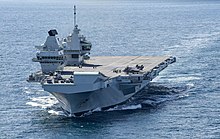Project Vixen
Project Vixen is the name of a Royal Navy programme examining the use of fixed-wing unmanned aerial vehicles (UAVs) from its two aircraft carriers. The project likely draws its name from the de Havilland Sea Vixen, notable for being the Royal Navy's first two-seat carrier-based aircraft capable of supersonic flight.[1]
Background
[edit]
The Royal Navy operates two aircraft carriers of the Queen Elizabeth-class, HMS Queen Elizabeth (R08) and HMS Prince of Wales (R09). Both of these ships feature a short take-off and vertical landing (STOVL) configuration which means they are limited to operating STOVL aircraft, such as the Lockheed Martin F-35B Lightning II, tiltrotor aircraft, or helicopters. This has presented the Royal Navy little choice in aircraft to undertake air-to-air refuelling, carrier on-board delivery and airborne early warning missions, which are better suited to heavier catapult-assisted but arrested recovery (CATOBAR) aircraft.[2][3] Fixed-wing UAVs, however, are typically lighter than conventional aircraft and, due to this, they have been considered for these missions by the Royal Navy.[1] In 2012, speaking on the behalf of the Ministry of Defence (MOD), Defence Minister, Philip Dunne, stated publicly that he expected the Royal Navy to utilise UAVs from the Queen Elizabeth-class "at some point during their 50-year lifespans".[4] When questioned about the prospect again, in 2016, another Defence Minister, Earl Howe, stated that the Royal Navy viewed them as an "operational advantage", adding that the Queen Elizabeth-class had extensive flight decks, hangars and engineering support facilities to accommodate them.[5] He also revealed that the Royal Navy had evaluated capability concept demonstrators with Joint Forces Command in 2015.[6] In January 2021, it was reported that the Royal Navy was seeking a heavy lift UAV for the aircraft carriers to assist with logistics.[7]
Overview
[edit]On 24 March 2021, Project Vixen was first revealed to the public as a programme to evaluate the use of fixed-wing UAVs from the Queen Elizabeth-class.[8] The programme is reportedly examining their use in strike and air-to-air refuelling missions.[1] During the same month, the MOD also issued a Request For Information (RFI) to the defence industry for electromagnetic catapults and arrestor cables capable of launching and recovering aircraft with a maximum weight of 24,948 kilograms (55,001 lb) and 21,319 kilograms (47,000 lb), respectively. The RFI also specified a need to install the system to the aircraft carriers within three–five years.[9][10] Due to being somewhat underpowered for manned fighter aircraft, like the F-35C, the system is more likely to be used for UAV's.[10]
According to an official Royal Navy publication, titled Future Maritime Aviation Force, which was originally published in December 2020, the Royal Navy aims to replace its helicopter-based airborne early warning (AEW) platform, the Merlin HM2 Crowsnest, with a fixed-wing UAV, currently known as Vixen, by 2030. The Royal Navy also expects to utilise Vixen in surveillance, air-to-air refueling, electronic warfare and strike roles.[11]
In September 2021, the Royal Navy launched a fixed-wing UAV from an aircraft carrier for the first time when a Qinetiq Banshee Jet 80+ was launched from the deck of HMS Prince of Wales. The demonstration was made under a separate project, named Project Vampire, to evaluate how lightweight fixed-wing UAVs can be integrated onto the aircraft carriers. The aircraft, which is a target drone by design able to carry a sensor and weapon payload, was launched via a catapult and recovered by parachute.[12][13]
Relation to RAF LANCA programme
[edit]In 2015, the RAF launched its Lightweight Affordable Novel Combat Aircraft (LANCA) programme to deliver a fixed-wing UCAV to augment its fighter aircraft. The Spirit Mosquito, developed by Team Mosquito, was selected as a technology demonstrator for this programme. Vixen was likely to be derived from LANCA or even be identical to it; in July 2020, RAF Air Chief Marshall Sir Michael Wigston stated: “The RAF envisions an aircraft derived from LANCA’s Mosquito phase being used on the Royal Navy’s aircraft carriers alongside F-35B Lightnings”.[14] However, on 24 June 2022, the MOD announced the cancellation of Project Mosquito due to other "more beneficial" and cost-effective solutions being available. It is currently unknown how this affects Project Vixen.[15]
References
[edit]- ^ a b c Lye, Harry (24 March 2021). "Royal Navy Project Vixen exploring potential Carrier UAS". Naval Technology. Retrieved 31 March 2021.
- ^ Majumdar, Dave (5 October 2018). "New Carrier, New Fighters: The F-35B Is Now Aboard Britain's Queen Elizabeth Aircraft Carrier". The National Interest. Retrieved 2 April 2021.
- ^ "Cats, traps and claptrap. Why the Royal Navy's new aircraft carriers operate VSTOL aircraft". Navy Lookout. 19 October 2019.
- ^ "Unmanned Air Vehicles". They Work For You. 25 November 2012. Retrieved 31 March 2021.
- ^ "Aircraft Carriers: Unmanned Air Vehicles". They Work For You. 2 March 2016. Retrieved 31 March 2021.
- ^ "Aircraft Carriers: Unmanned Air Vehicles". They Work For You. Retrieved 31 March 2021.
- ^ "Royal Navy looking for heavy lift drone". UK Defence Journal. 1 January 2021. Retrieved 2 April 2021.
- ^ "Maritime Enterprise Planning Group" (PDF). GOV.UK. Retrieved 2 April 2021.
- ^ "Electromagnetic Catapults For Carriers Sought By UK Royal Navy". Aviation Week. 1 March 2021. Retrieved 31 March 2021.
- ^ a b Lye, Harry (9 March 2021). "Royal Navy seeking information on cats and traps to launch drones". Naval Technology. Retrieved 31 March 2021.
- ^ Allison, George (2 April 2021). "Royal Navy looking at fixed-wing carrier based drone for AEW". UK Defence Journal. Retrieved 7 April 2021.
- ^ "Drones launched from HMS Prince of Wales during landmark demonstration". Royal Navy. 29 September 2021. Retrieved 27 October 2021.
- ^ "Royal Navy Is Experimenting With Launching Jet-Powered Drones From Its New Carriers". The Drive. 30 September 2021. Retrieved 27 October 2021.
- ^ "Cats, traps and UAS – the Royal Navy considers options for carrier-launched drones". NavyLookout. 14 April 2021. Retrieved 19 September 2021.
- ^ Allison, George (25 June 2022). "Mosquito drone project swatted". UK Defence Journal. Retrieved 25 June 2022.
